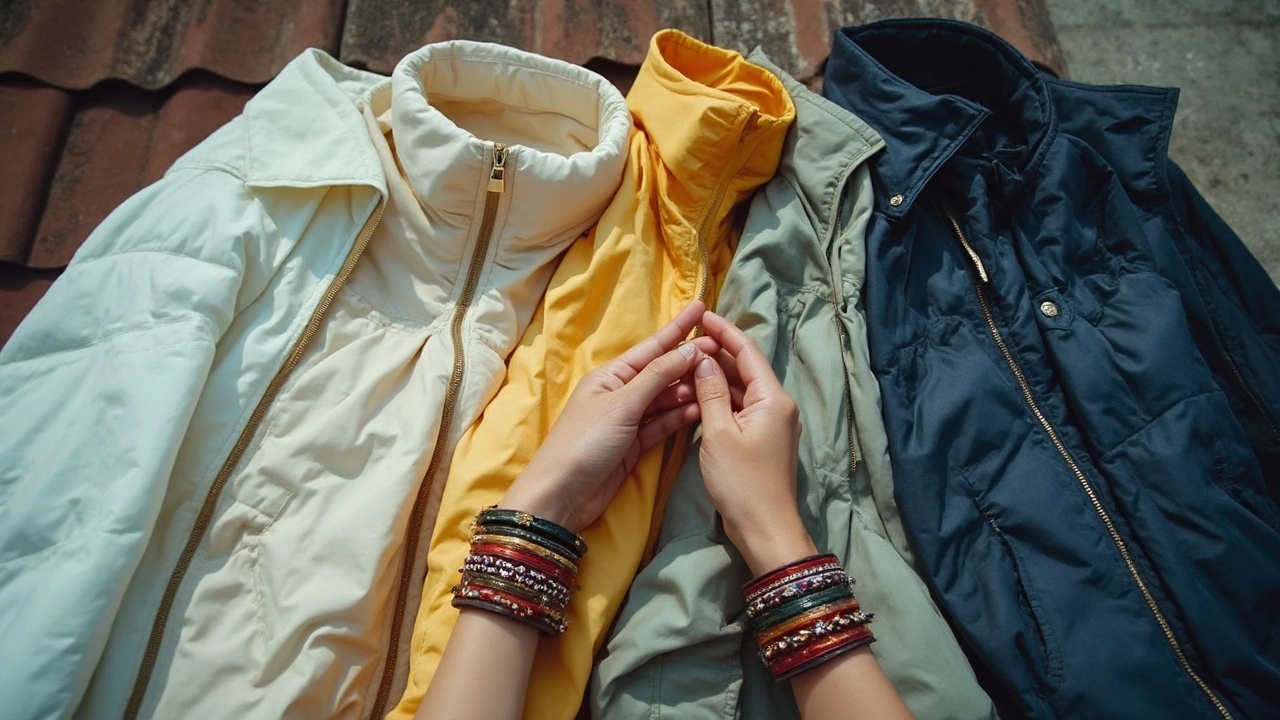Best Color Jacket for Staying Cool in Summer: What Actually Works?

Not all summer jackets are created equal—especially when you look at color. Ever noticed how you feel way hotter in a black hoodie compared to something white or pastel? The color you wear actually changes how much heat you keep or lose. It’s not just a fashion thing; it’s a real science thing.
If you’ve ever wondered why folks in super hot countries don’t walk around in dark jackets, it’s because of one basic rule: dark colors soak up sunlight and get hotter, while light colors bounce most of it away. That’s why you’ll see loads of white, beige, or pale blue jackets in stores every summer—they're not just there to look cute.
But shade isn’t always enough. Think about that time you left a navy jacket on the picnic table and it felt too hot to touch. Yep, that’s the color working against you. On the other hand, grab a white or pale yellow jacket, and you’ll notice it doesn’t trap nearly as much heat.
Planning to pick up a new summer jacket? Color should be the first thing on your mind if you want to stay cool instead of sweaty and uncomfortable. Let’s bust some myths and get straight into what actually matters.
- Why Color Matters More Than You Think
- The Science: Light vs. Dark Jackets
- Unexpected Mistakes People Make
- Bonus Tips for Summer Comfort
- Best Jacket Picks for Beating the Heat
Why Color Matters More Than You Think
If you’re thinking a jacket is just a jacket, here’s a reality check: the color jacket you pick for summer has a huge impact on how you feel. It’s not just about looks either. Science backs this up. Darker colors—especially black and navy—actually turn you into a mini heat magnet. That’s because dark fabrics absorb all visible wavelengths of sunlight, turning them straight into heat you can feel on your skin.
Lighter colors, like white, beige, and pale gray, work differently. Instead of sucking in sunlight, they reflect most of it away from your body. That keeps the inner layer of your jacket—and your skin—noticeably cooler. This isn’t just a small detail. Real-life tests show that a black cotton shirt can get up to 15°C (about 27°F) hotter than a white one in direct sun. Now imagine that with a thicker jacket!
Here’s a quick look at how different colored jackets stack up outdoors:
| Jacket Color | Surface Temp. After 1hr Sun |
|---|---|
| Black | 58°C (136°F) |
| Navy | 50°C (122°F) |
| Red | 47°C (117°F) |
| Beige | 39°C (102°F) |
| White | 35°C (95°F) |
That table pretty much says it all. If you care about staying cool in the summer, the lighter the color, the better. Ask anyone who’s picked up a dark jacket sitting in the sun—it doesn't just look hot, it can actually hurt to touch.
So next time you’re shopping, skip those insta-worthy dark jackets. Look for lighter shades and feel the difference on even the hottest day.
The Science: Light vs. Dark Jackets
Here’s where things get really interesting. When you’re picking a color jacket for summer, it’s not just about style. It’s about actual science—the way colors absorb and reflect sunlight.
Light colors, like white, pale gray, and beige, reflect most of the sun’s rays. Dark colors, like black, navy, and deep green, absorb pretty much all of them. This means a dark jacket will heat up fast, while a light one stays way cooler. It’s why you can touch a white car after it’s baked in the sun, but you’ll burn your hand on a black one. Same rules apply to your clothes.
This isn’t just old advice your grandma gave you. Research from the National Renewable Energy Laboratory found that black fabric can soak up as much as 90% of the sun’s energy, while white reflects up to 80%. That’s a huge difference if you’re outside even for just half an hour.
"The difference in heat absorption between a white and black shirt is often more than 20°F on a sunny day." – Dr. Stephanie Taylor, Harvard School of Public Health
If you’re a numbers person, take a look at this:
| Jacket Color | Average Surface Temp (°F) After 30 min Sun |
|---|---|
| Black | 120 |
| Navy Blue | 115 |
| Light Gray | 102 |
| White | 97 |
So, if you want to stay cool, it’s clear: go light. Choosing the right color isn’t just about that fresh summer look—it’s the key to making sure you’re not a sweaty mess by lunchtime.

Unexpected Mistakes People Make
Most people think grabbing any light-colored jacket is enough, but that’s not always true. Some summer jackets look cool but can make you sweat anyway because of the fabric or details you didn’t think about. Let’s get real about where people mess up.
- Choosing the wrong material: Even a white or pale jacket can roast you if it’s made of polyester. Synthetic fabrics trap heat and block airflow. Natural fabrics like cotton or linen are better for summer because they breathe.
- Ignoring the lining: Plenty of folks don't look inside their summer jacket at all. If there’s a dark or synthetic lining, you might end up as sweaty as if you wore a darker outer jacket.
- Falling for "UV protection" labels only: UV protection sounds fancy but doesn’t mean it keeps you cool. It just blocks sunburn. Light, loose, and breathable always beat tight, heavy, or plastic-feeling jackets, no matter what the label says.
- Too many unnecessary features: Big hoods, loads of pockets, or double layers look handy but only trap more heat. The less bulk, the cooler you’ll be.
- Forgetting about fit: Some people grab a tight, white jacket thinking color solves everything. But if it clings to your body, you’ll sweat more. Summer jackets should be loose and let air move around.
Check this out—a test from a consumer research group found that pale blue and beige jackets made with thin cotton were up to 8°C cooler on the inside than dark, synthetic ones after sitting in direct sunlight for 30 minutes:
| Jacket Color | Material | Inside Temp Increase (°C) |
|---|---|---|
| Pale Blue | Cotton | +2 |
| Beige | Cotton/Linen | +3 |
| White | Polyester | +7 |
| Navy | Polyester | +10 |
Bottom line: don’t let a light color fool you—check material, lining, features, and fit. You’ll be way happier if you do.
Bonus Tips for Summer Comfort
Choosing the right color jacket is a great start, but there’s more you can do to beat the heat. When the weather cranks up, every small trick counts to keep you cool and comfy.
- Go for natural fabrics. Stick with cotton or linen instead of synthetic stuff like polyester. Natural fibers let your skin breathe, which really helps when it’s hot.
- Pick jackets with vents or mesh panels. These features actually let air in and sweat out, so you don’t end up sticky and uncomfortable.
- Avoid too-tight fits. Looser jackets let more air move around your body, which means less trapped heat.
- Look for moisture-wicking linings. A lot of newer summer jackets come with special linings that pull sweat off your skin. This can make a huge difference if you’re out for more than a quick walk.
- Go light on layers. The less you wear under your jacket, the easier it is for your body to cool down. If you need to wear a shirt, stick with a thin, light one.
Ever wondered if UV protection jackets really do anything? They actually can. Some have special coatings or tightly-woven fabrics that help block the sun’s rays. These are called UPF-rated jackets. According to dermatologists, a UPF rating of 30 or higher offers decent protection if you’ll be out long.
| Feature | Summer Comfort Benefit |
|---|---|
| Light Color | Reflects heat, keeps skin cooler |
| Loose Fit | Increases airflow |
| Vents/Mesh Panels | Improves breathability |
| Natural Fabric | Better at absorbing sweat |
| UPF Protection | Blocks harmful UV rays |
And one last thing: wash your summer jackets often. Sweat, sunscreen, and grime can mess with the fabric’s performance and make you feel warmer. Keeping your jackets clean helps you get the most out of every comfort feature you paid for. Small step, big payoff when the heat won’t give up.

Best Jacket Picks for Beating the Heat
It’s wild how much of a difference the right color jacket can make when you’re out in the summer sun. If you want the best shot at staying cool, go for jackets in these colors: white, beige, light gray, pale blue, or soft pastel shades. Light colors reflect most sunlight. One classic test showed that people wearing light clothing in heat absorb up to 40% less thermal energy compared to folks in dark gear.
But it’s definitely not just about color. You want to look for summer jackets made of lightweight, breathable fabrics. Cotton, linen, and some tech-fabrics (like moisture-wicking polyester used in sportswear) are your go-tos. In fact, a lot of big name brands now offer "cooling jackets" that mix light colors with nylon or mesh panels to help sweat evaporate faster.
- White denim jackets: Classic, surprisingly versatile, and reflect sunlight better than traditional blues or blacks.
- Beige or pale khaki windbreakers: Super light and great for blocking out sun without feeling stuffy.
- Pale blue cotton bombers: Bonus points for style, breathability, and not soaking up heat.
- Performance zip-ups in pastel colors: Usually found in hiking or outdoor stores, and made for serious sweat wicking.
- Light gray cardigans or shirt-jackets: Work well for layering when you’re stuck between blazing sun and freezing office AC.
Here’s a quick comparison of how different jacket colors heat up in direct sun—check out the numbers (recorded after just 45 minutes in full sun):
| Jacket Color | Surface Temp (°F) |
|---|---|
| Black | 122 |
| Navy | 118 |
| Olive Green | 110 |
| Light Blue | 101 |
| White | 95 |
If you’re shopping online, search with keywords like ‘cooling jacket,’ ‘summer weight jacket,’ or ‘UV protective jacket’—brands like Uniqlo, Patagonia, and Columbia make solid picks that cost about the same as regular outerwear. Just avoid leather or any heavy synthetic layers—the lighter and looser, the better.
One last hack: If you absolutely have to wear a darker jacket, think about layering a loose white or beige tee underneath. You’ll at least keep heat off your skin, even if the outer layer gets a bit toasty. No fancy tricks, just smart choices based on what actually works when the sun’s blazing.